
The European roller is the only member of the roller family of birds to breed in Europe. Its overall range extends into the Middle East, Central Asia and the Maghreb.

The Eurasian wryneck or northern wryneck is a species of wryneck in the woodpecker family. This species mainly breeds in temperate regions of Europe and Asia. Most populations are migratory, wintering in tropical Africa and in southern Asia from Iran to the Indian subcontinent, but some are resident in northwestern Africa. It is a bird of open countryside, woodland and orchards.

The common redshank or simply redshank is a Eurasian wader in the large family Scolopacidae.

The Eurasian coot, also known as the common coot, or Australian coot, is a member of the rail and crake bird family, the Rallidae. It is found in Europe, Asia, Australia, New Zealand and parts of North Africa. It has a slaty-black body, a glossy black head and a white bill with a white frontal shield. The sexes are similar. Similar looking coot species are found throughout the world, with the largest variety of coot species living in South America.
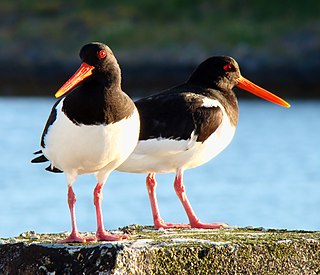
The Eurasian oystercatcher also known as the common pied oystercatcher, or palaearctic oystercatcher, or just oystercatcher, is a wader in the oystercatcher bird family Haematopodidae. It is the most widespread of the oystercatchers, with three races breeding in western Europe, central Eurosiberia, Kamchatka, China, and the western coast of Korea. No other oystercatcher occurs within this area. The extinct Canary Islands oystercatcher, formerly considered a distinct species, may have actually been an isolated subspecies or distinct population of the Eurasian oystercatcher.
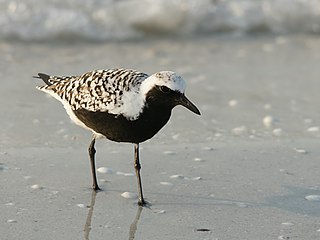
The grey plover or black-bellied plover is a large plover breeding in Arctic regions. It is a long-distance migrant, with a nearly worldwide coastal distribution when not breeding.

The common wood pigeon or common woodpigeon, also known as simply wood pigeon or woodpigeon, is a large species in the dove and pigeon family (Columbidae), native to the western Palearctic. It belongs to the genus Columba, which includes closely related species such as the rock dove. It has historically been known as the ring dove, and is locally known in southeast England as the "culver"; the latter name has given rise to several areas known for keeping pigeons to be named after it, such as Culver Down. It has a flexible diet, predominantly feeding on vegetable matter, including cereal crops, leading to them being regarded as an agricultural pest. Wood pigeons are extensively hunted over large parts of their range, but this does not seem to have a great impact on their population.
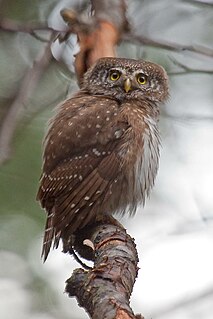
The Eurasian pygmy owl is the smallest owl in Europe. It is a dark reddish to greyish-brown, with spotted sides and half of a white ring around the back of the neck. This species is found in the boreal forests of Northern and Central Europe to Siberia.

The Eurasian stone-curlew, Eurasian thick-knee, or simply stone-curlew is a northern species of the Burhinidae (stone-curlew) bird family.

The black-backed woodpecker, also known as the Arctic three-toed woodpecker, is a medium-sized woodpecker inhabiting the forests of North America.

The Eurasian bullfinch, common bullfinch or bullfinch is a small passerine bird in the finch family, Fringillidae. In Anglophone Europe it is known simply as the bullfinch, as it is the original bird to bear the name bullfinch.

The Eurasian scops owl, also known as the European scops owl or just scops owl, is a small owl in the typical owl family Strigidae. Its breeding range extends from southern Europe eastwards to southern Siberia and the western Himalayas. It is migratory, wintering in Africa south of the Sahara.

The boreal owl or Tengmalm's owl is a small owl in the "true owl" family Strigidae. It is known as the boreal owl in North America and as Tengmalm's owl in Europe after Swedish naturalist Peter Gustaf Tengmalm or, more rarely, Richardson's owl after Sir John Richardson.

The middle spotted woodpecker is a European woodpecker belonging to the genus Dendrocoptes.
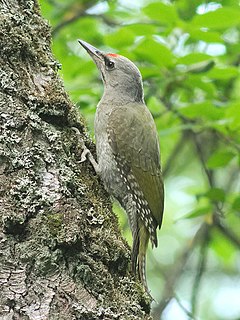
The grey-headed woodpecker, also known as the grey-faced woodpecker, is a Eurasian member of the woodpecker family, Picidae. Along with the more commonly found European green woodpecker and the Iberian green woodpecker, it is one of three closely related sister species found in Europe. Its distribution stretches across large parts of the central and Eastern Palaearctic, all the way to the Pacific Ocean.

Picoides is a genus of woodpeckers that are native to Eurasia and North America, commonly known as three-toed woodpeckers.

The American three-toed woodpecker is a medium-sized woodpecker, which is native to North America.

The Eurasian penduline tit or European penduline tit is a passerine bird of the genus Remiz. It is relatively widespread throughout the western Palearctic. It is migratory in the northern part of its range but resident in the southern part.
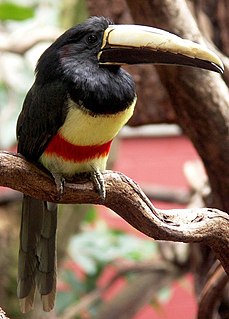
The black-necked araçari, is a species of bird in the toucan family. It is found in Brazil, French Guiana, Guyana, Suriname, and Venezuela.
In the 10th edition of Systema Naturae, published in 1758, the Swedish naturalist Carl Linnaeus described 554 species of bird and gave each a binomial name.























